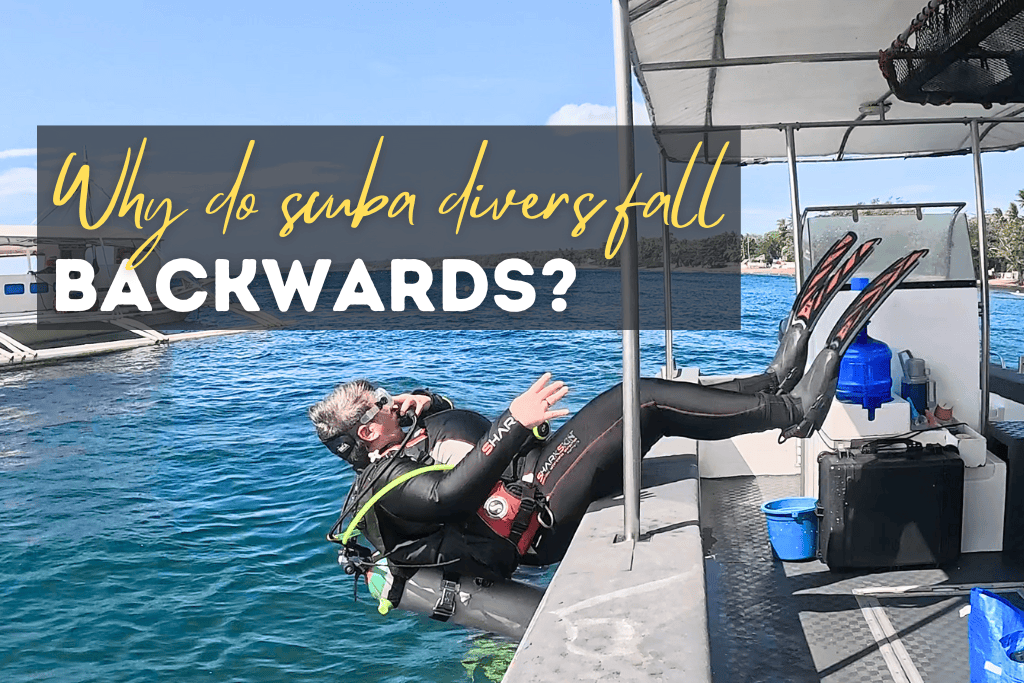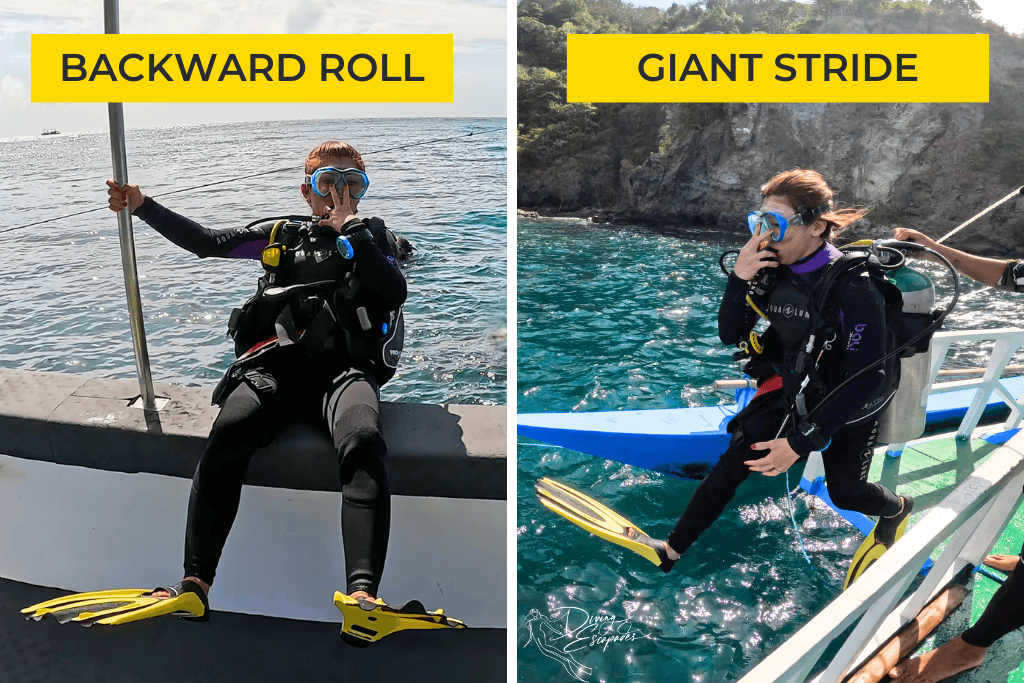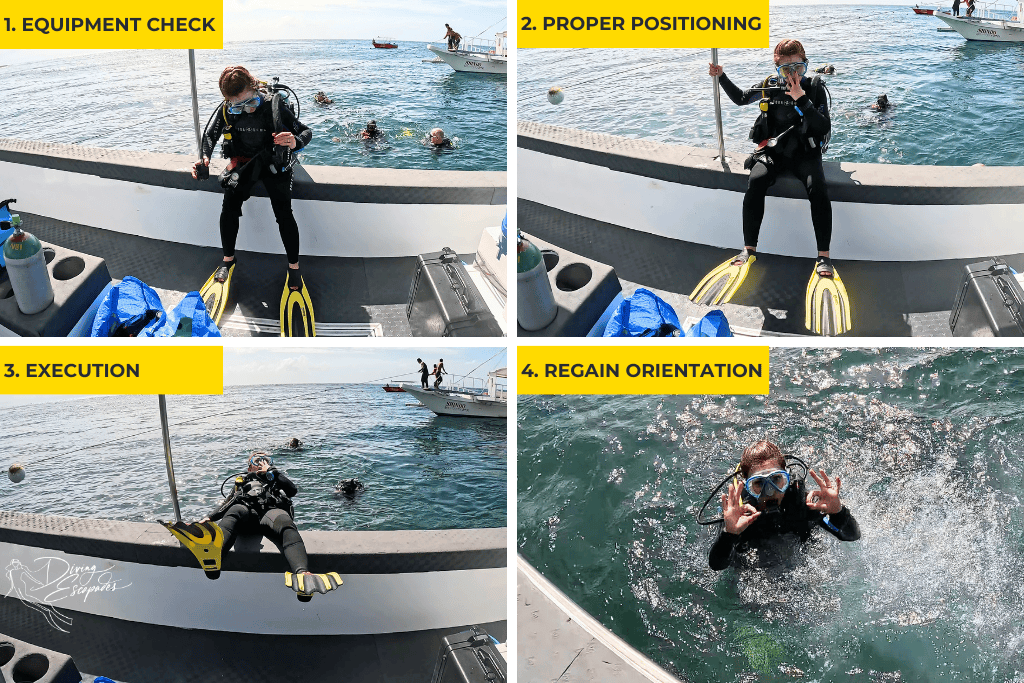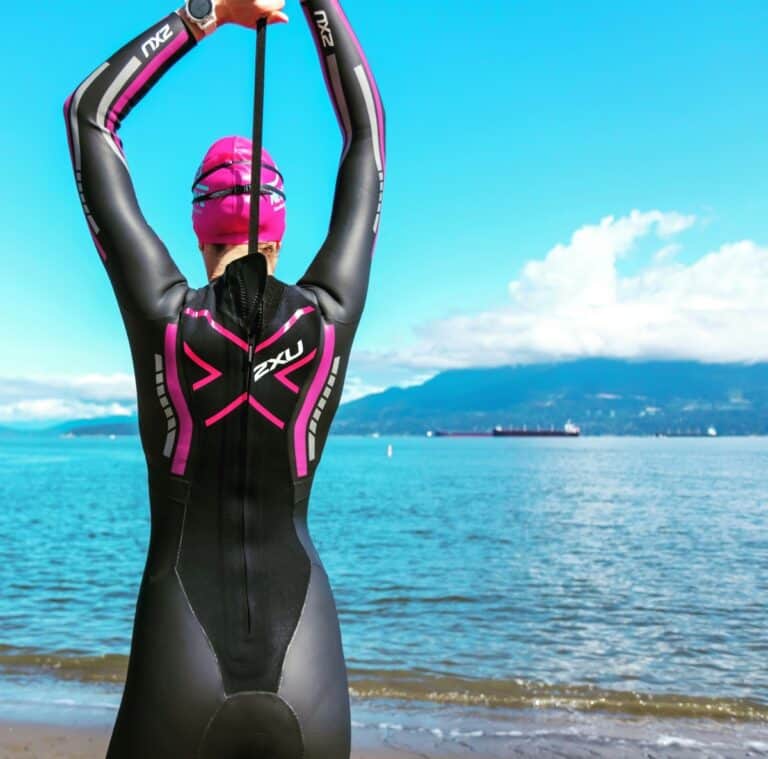Why do SCUBA divers fall backwards? Answers and Practical Tips

If you’ve ever been out on a boat with SCUBA divers, you’ve probably noticed them falling backwards into the water. I used to think it was just for show, but it turns out there’s a lot more to it.
So, why do SCUBA divers fall backwards? Let’s grab our snorkels and fins and dive into the reasons behind this iconic move.
Why Do SCUBA Divers Fall Backwards?
Straight answer: SCUBA divers fall backwards from the boat into the water to protect their gear and ensure a safe, controlled entry.
This technique, called the “backward roll”, keeps the heavy tank on their back secure and minimizes the risk of injury or equipment damage. Read on to learn more about why this method is essential.
The Basics of SCUBA Diving Entry Techniques
Before we plunge into the specifics of the backward roll, let’s take a quick look at the other common entry method: the giant stride. Each technique has its own place and purpose when SCUBA diving.
The Backward Roll Entry
Imagine that you’re seated on the edge of a boat, fully geared up with your tank, BCD (buoyancy control device), and fins. The boat rocks gently beneath you, and you’re about to make your descent underwater.
Instead of standing up and awkwardly hopping overboard, you simply lean back and let gravity do the work. It’s the backward roll, and it’s as smooth as it sounds.
Divers often use this technique when diving from small boats, where standing up to perform a giant stride might not be feasible. The backward roll allows for a controlled and seamless entry, making it the go-to method in many situations (again, when diving from small boats).
The Giant Stride Entry
Now, let’s talk about the giant stride. This method is about taking a big, confident step off a diving board, only you’re fully equipped with SCUBA gear and aiming for the ocean instead of a swimming pool.
Divers typically use the giant stride when entering the water from larger boats, piers, or platforms. You stand at the edge, take a large step forward, and boom—you’re in the water. It’s straightforward, but it requires a stable platform to execute effectively.

Why Do SCUBA Divers Fall Backwards? Detailed Answer
Alright, it’s time to answer the burning question in detail: why do SCUBA divers fall backwards? Let’s break it down.
Safety Considerations
First and foremost, safety is super important in SCUBA diving. The backward roll helps protect both the diver and their equipment. When you fall backward, your gear, particularly the tank strapped to your back, stays in place.
Imagine trying to leap forward with a heavy, awkward tank on your back—it’s a recipe for a faceplant or worse. Falling backward ensures that the weight of the tank doesn’t shift or cause any unwanted mishaps.
Practical Benefits of the Backward Roll
Besides safety, the backward roll is incredibly practical. It allows divers to enter the water quickly and efficiently, which is crucial when you’re eager to explore underwater.
The backward roll is also less physically demanding than other entry methods, making it accessible to divers of all experience levels. Plus, it’s a great way to start your dive with a touch of elegance and grace—after all, who doesn’t want to look cool while diving?
Scientific Explanation of the Backward Roll
Let’s get a bit scientific for a moment. When you fall backward, you use your body’s natural momentum to create a smooth and controlled entry into the water. The physics behind this move are simple yet effective.
By leaning back and allowing gravity to do its thing, you minimize the impact and ensure a stable descent. It’s like the universe giving you a gentle push into the deep blue.
How to Perform a Backward Roll Entry
Now that we’ve covered the “why,” let’s talk about the “how.” Performing a backward roll entry might seem daunting at first, but with a bit of practice, you’ll be rolling into the water like a pro.
Step-by-Step Guide

1️⃣ Equipment Check: Before you even think about entering the water, double-check your gear. Make sure your tank is secure, your mask is in place, and your fins are ready to go.
2️⃣ Proper Positioning: Sit on the edge of the boat with your legs dangling over the side. Scoot back until your tank is just over the edge.
Before you execute your backward roll, make sure to check that no one is in the water where you’ll be entering—you don’t want to hit anyone.
3️⃣ Execution of the Backward Roll: Take a deep breath, hold your mask and regulator in place with one hand, and tuck your chin to your chest. Lean back and let gravity do the rest.
You’ll fall backward into the water, and the moment your tank hits, you’ll feel a gentle push that propels you away from the boat.
4️⃣ Regain Orientation: Once you’re in the water, take a moment to reorient yourself. Check your surroundings, signal to your dive buddy, and prepare for your descent.
Common Mistakes to Avoid
Even seasoned divers can make mistakes, but here are a few common ones to watch out for:
⚠️ Improper Equipment Placement: Ensure your tank is positioned correctly. A poorly secured tank can cause all sorts of problems, from awkward entries to potential injuries.
⚠️ Incorrect Body Positioning: Tuck your chin and keep your body straight as you fall. This helps maintain control and ensures a smooth entry.
Comparing Backward Roll and Giant Stride
Both the backward roll and the giant stride have their advantages and each is suited to different diving scenarios. Understanding when to use each technique can enhance your diving experience.
When to Use Each Technique
- Backward Roll: Ideal for small boats and situations where space is limited. It’s also great for divers who prefer a gentler, more controlled entry.
- Giant Stride: Best for larger boats, piers, and platforms where you have a stable surface to stand on. It’s a more dynamic entry and works well in calm conditions.
Risks and Benefits
- Advantages of the Backward Roll: Less physical strain, better control over equipment, and reduced risk of injury.
- Advantages of the Giant Stride: Quick entry, useful in a variety of conditions, and allows for immediate descent.
- Potential Drawbacks of Each: The backward roll may feel awkward initially, and the giant stride requires a stable platform and can be physically demanding.
Frequently Asked Questions
Let’s address some common concerns and questions about backward roll entries. If you’ve got questions, I’ve got answers—and maybe a few laughs along the way.
What if I feel uncomfortable?
First off, it’s totally normal to feel a bit uneasy at first. Falling backwards off a boat isn’t exactly something we do every day—unless you’re a professional stunt person.
Take your time and practice in a pool where the stakes are low. It’s like learning to ride a bike, but with more bubbles and less road rash.
Don’t hesitate to ask for guidance from experienced divers. They’ve all been there, and trust me, they have stories.
How do I keep my mask from flying off?
Hold onto your mask and regulator with one hand while you roll. It’s like holding onto your hat in a windstorm—just underwater. This simple move will keep your gear in place and your dive off to a good start.
I have trouble staying balanced. Any tips?
Staying balanced can feel tricky at first. When you’re on the boat, sit on the edge with your legs dangling over the side. Scoot back slowly until your tank is just over the edge.
Think of it like sitting in a rocking chair—if that rocking chair were floating on the open sea. Practice makes perfect, so keep at it!
Can I switch to another method?
Absolutely! The backward roll is just one of many entry techniques. If it doesn’t float your boat (pun intended), you can try the giant stride.
If you prefer to avoid both the backward roll and the giant stride, you might want to start with shore diving. Just walk into the beach with your gear on (except for the fins) and begin your dive from there.
Find what works best for you and your diving environment. The ocean is big enough for all kinds of splashy entrances.
What if I accidentally roll onto someone?
Let’s avoid turning this into a slapstick comedy. Always check the water before you roll. A quick glance to ensure no one is swimming below you can save you from awkward underwater apologies.
Remember, visibility is key—both above and below the surface.
More Practical Tips
✅ Stay Relaxed: Tension is your enemy. Try to stay relaxed and let gravity do the work.
Think of it as a trust fall, but instead of falling into your friends’ arms, you’re falling into the welcoming embrace of the ocean.
If you tense up, you’re more likely to flop awkwardly, which is entertaining for onlookers but not great for you.
✅ Buddy Up: Always dive with a buddy. Not only does this add a layer of safety, but your buddy can also provide feedback and a steady hand if needed.
Plus, you’ll have someone to laugh with about the time you almost did a backward somersault instead of a roll.
✅ Take It Slow: There’s no rush. Scoot back bit by bit until you’re in the right position. This isn’t a race, and slow and steady really does win the dive.
Plus, taking your time reduces the chances of making a mistake.
✅ Visualize Success: Before you roll, take a moment to visualize the perfect entry.
Picture yourself sliding smoothly into the water, making barely a splash, and your dive buddy giving you a thumbs-up. Positive visualization can really help set the tone.
✅ Get Feedback: After a few rolls, ask for feedback. Did it look smooth? Did you hold your gear properly?
Constructive feedback can be incredibly valuable, and it’s also an opportunity for a good laugh as you share tales of your first attempts.
The Wrap Up: Why SCUBA Divers Fall Backwards
In summary, SCUBA divers fall backwards from the boat into the water for several reasons: safety, practicality, the physics of a smooth entry, and because it’s the best technique when you’re on a small boat.
The backward roll is an essential skill that enhances the diving experience, ensuring that divers can explore underwater safely and efficiently.
So, the next time you see a diver performing that graceful backward roll, you’ll know there’s more to it than just looking cool.
It’s a technique grounded in safety and practicality, designed to make each dive as enjoyable and hazard-free as possible.
Happy diving!






